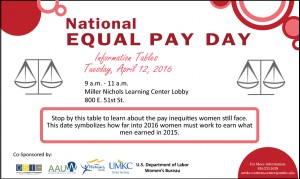by Logan Snook
On the eve of National Equal Pay Day, let’s talk about job growth for women, a significant aspect of closing the gap between genders and creating a more stable future for women in the U.S.
According to the most recent employment summary release from the Bureau of Labor Statistics, released April 1st, states that 215,000 jobs were created in March. Great news! Of the 215,000 jobs created in March, two-thirds went to women. More good news! What is not good news is that 34% of these positions were low-wage, primarily in retail and hospitality and leisure. Men also saw a growth in these fields, with a 55% increase of low-wage jobs.
While 34% does not seem like much, figures from the last year show that the majority of jobs created were low-wage. According to the Pew Research Center, 40% of breadwinners in U.S. families are mothers, and married mothers are either the primary or co-breadwinners in over half of families. When you put in place that many of the jobs going to women are low-wage positions, a huge red flag should go up. The National Women’s Law Center states that women are more than twice as likely as men to work in occupations that typically pay $10.50 per hour or less – some states they are three times as likely. These jobs include retail, food service, and child care. When you add in the fact that women are also paid 15% less than their male coworkers, these statistics become even more disheartening. The stress of putting food on the table, paying for health care, and providing a solid education is a burden many women in this country currently face.
The next problem: with minimum-wage job growth on the incline, pay for these jobs has not seen similar improvements over the past several decades. The current mandated minimum wage is $7.25 an hour. If the value of minimum wage stayed consistent over the last 40 years, the current minimum wage should be $10.90 an hour. That is a difference of $3.65 an hour. Combining the pay from minimum-wage jobs as well as the loss from the pay gap, women are set up for an unstable future for themselves and their families. With the buzz of states proposing to raise the minimum-wage (and those who have already implemented a higher wage), there is some hope for more security for the staggering percentage of women (and minorities) working low-wage jobs.
While growth in fields with pay above the minimum wage, such as healthcare and education, are positive signs, there is a lot that still needs to be done with lower paying positions and the minimum-wage. Creating sustainable jobs for women will help ensure that their lives and those of their families can live their day-to-day lives with less financial insecurities, and lead to prosperous futures.
Want to learn more about equal pay and improving the lives of women in the U.S.? Stop by the National Equal Pay Day Information Table hosted by the Women’s Center on Tuesday, April 12th, from 9:00am – 11:00am at the Miller Nichols Learning Center Lobby for trivia, coffee and donuts.